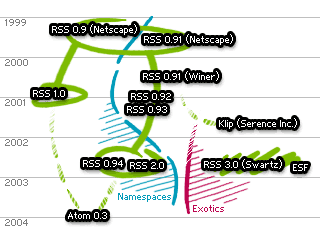Thiemos Archiv
- Monday, 2004-01-12 12:34
- The RSS 0.9 to Atom timeline is still a mystery to me. Nevertheless I tried to display the relations and misrelations between all the formats developed out there. I may be wrong, so the graph shows nothing else than my opinion.

(Es gibt auch eine deutsche Übersetzung dieses Textes.)
In 1999 the My Netscape Network team introduced RSS 0.9, RDF Site Summary, based on the Ressource Description Framework developed by the World Wide Web Consortium in February 1999. An RSS 0.9 »channel« contained titles and links, nothing more. But, and that's what suprised me for the first time, it already was part of the metadata master plan called »RDF«. (For example, the more and more popular FOAF is RDF too.)
RSS 0.91, Rich Site Summary, introduced by the Netscape team a few months later, dropped it's roots in RDF and added a few new elements (items may have descriptions now) inspired by the format UserLand use since 1997 (not in the graph). RSS 0.91 became a slightly simpler format but gave away the chance to be in a actual metadata network.
In 2000 Dave Winer rewrote the RSS 0.91 specification for UserLand, almost without changing anything (the <!DOCTYPE> was removed and <image> became a required element, a rule I ignore today). A continuous process of developement followed. RSS 0.92 added <category>, <cloud>, <enclosure> and <source>, some elements became optional and all size and number limits where eliminated. RSS 0.93 introduced publication and expiration dates on the item level.
In the meantime, RSS 1.0 by the RSS-DEV working group came out. It was a successor of RSS 0.9 and had nothing to do with the other branch (separated by the blue line in the graph). In contrast to RSS 0.91, which lost any namespace capability, the entire RSS 1.0 specification was build on RDF and namespace-based modules such as Dublin Core. In other words, RSS 1.0 was nothing but a module for RDF and therefore based on existing standards, well adopted, developed and documented by the W3C.
This was where the »war« started, I think.
Winer's RSS 0.94, one and a half year later, was a draft and never released. In fact, RSS 0.94 simply was renamed into RSS 2.0. It was another try to nail down the specification to a final state. Some more elements where added, e.g. <author>, <comments> and <guid>, some more elements where made optional. And, surprise, namespaces where back. This pushed RSS 2.0 back in the same scope as RSS 1.0. They became interchangeable again.
The nevertheless ongoing »war« between the RSS 1.0 and the RSS 0.91 line got on some people nerves so they came up with their own formats totaly different from the others. For example, RSS 3.0 (based on RFC 822 from 1982) by Aaron Swartz, one of the RSS 1.0 developers, or ESF, Epistula Syndication Format, are plain text formats, well readable by both humans and machines. Even if people like them, as I do, they are not well supported of course.
On the same »exotic« side I put the Klip and KlipFood format (it's a pair, one providing a channel, the other providing the items) as a special case. I don't know why it's so different from RSS nor do I know why it's so well supported today. But it seems obvious it was split from the RSS 0.91 branch.
And today, Atom is in blossom. A star on the smoking horizon of RSS. No, I do not like Atom. To be more precise: I do not need it. Everything I want to do I'm able to do with RSS 1.0. For compatibility reasons I use RSS 2.0. (Even your RSS 0.91 reader is able to process RSS 2.0, as long as it's not too funky, of course.) And for the fun of it, RSS 3.0 feels old school.
On the other hand, Atom is just another language. Languages can be translated. Kommentare zu diesem Beitrag können per E-Mail an den Autor gesandt werden.
habe da mal ne Frage
Gibt es diese Erklärung auch in deutsch? Würde ich gerne mit Deiner Erlaubnis in unserem neu eingerichteten RSS-Forum übernehmen. Wäre Dir für eine Rückantwort sehr dankbar :-)
Gruß, Jürgen